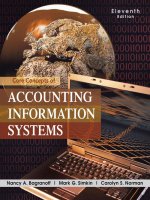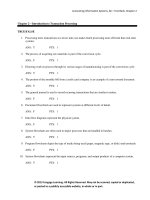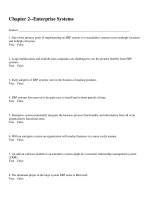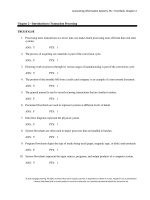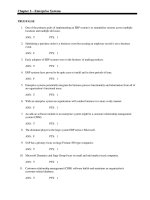Accounting information systems ch10
Bạn đang xem bản rút gọn của tài liệu. Xem và tải ngay bản đầy đủ của tài liệu tại đây (2.26 MB, 46 trang )
The Order
Entry/Sales
(OE/S)
Process
1
Learning Objectives
•
•
•
•
•
Understand relationship between the OE/S
process and its business environment
Appreciate the potential of the OE/S process
to assist management decision making.
Become familiar with technologies commonly
used in contemporary implementations for
the OE/S process
Achieve a reasonable level of understanding
of the OE/S process’ logical and physical
characteristics
Know the OE/S process and information
process control goals and to recognize the
significance of some business process
control plans commonly used to control
these processes
OE/S
OE/S Spoke on AIS Wheel
•
•
•
In this chapter, we spotlight
one business process, the
order entry/sales (OE/S)
process
We will describe the various
users of the OE/S process,
each having their own view
of the enterprise system and
enterprise database.
In addition, we will analyze
the process controls related
to the OE/S process
3
Introduction
• The order entry/sales (OE/S) process
includes the first four steps in the order-tocash process
1.
2.
3.
4.
pre-sales activities
sales order processing
picking and packing the goods
shipping
• Billing and processing the customer
payment, are described in Chapter 11, the
billing/accounts receivable/cash receipts
process
4
Process Definition and Functions
• The primary function of the OE/S
process is to create information flows
that support the following:
1. Repetitive work routines of the sales order
department, the credit department, and the
shipping department
2. Decision needs of those who manage
various sales and marketing functions
5
Horizontal View OE/S
1. Customer
places order
6
Horizontal View OE/S
2. Sales order
department
requests credit
approval from
the credit
department
7
Horizontal View OE/S
3. Credit
department
informs sales
order
department of
disposition of
credit request
8
Horizontal View OE/S
4. Sales order
department
acknowledges
order to the
customer
9
Horizontal View OE/S
5. Sales order
department
notifies shipping
department of
sales order
10
Horizontal View OE/S
6. Sales order
department
notifies
warehouse and
B/AR/CR
process of
shipment
11
Horizontal View OE/S
7. Warehouse
sends
completed
picking ticket to
shipping
12
Horizontal View OE/S
8. Shipping
department
informs sales
order
department of
shipment
13
Horizontal View OE/S
9. Shipping
department
informs carrier,
B/AR/CR
process, and
general ledger
process of
shipment
14
Vertical Perspective of the OE/S
System
15
MANAGING THE OE/S PROCESS:
SATISFYING CUSTOMER NEEDS
• Most important asset is not capitalized on the balance
sheet, a happy customer
• Global competition has increased significantly
• What does this situation mean for the OE/S process?
– This has expanded the type and amount of data collected by the
OE/S process regarding a firm’s customer population
– Many organizations have developed a separate marketing
information system to assist decision making in the marketing
function
– Often tightly coupled with the information systems supporting the
OE/S process
– With enterprise systems, customer relationship management
(CRM) systems often share the same underlying database
– Mass marketing or segmented marketing is being replaced with
marketing to smaller portions of the customer population
– The ultimate aim is to concentrate on the individual consumer
16
Questions that need answers
• Where is sales volume (quantity and dollars)
concentrated?
• Who are the specific major customers (by
sales and by profitability), both present and
potential?
• What opportunities exist to sell after-sales
services?
• What types of advertising and promotions
have the greatest influence on customers?
17
Using Data Mining to Support
Marketing
• Intended to allow the use of sophisticated
statistical and other analytical software to
help an organization’s members develop
insights about customers, processes, and
markets
– Data warehousing and data mining have
become common application to increase the
effectiveness of pricing and promotions
18
Global e-Business
• E-Business systems are broken into two
categories: buy-side and sell-side
– Buy Side
• Buy-side systems use the Internet to automate and manage
corporate vendors and purchases.
• The predominant technology in this area is electronic data
interchange (EDI)
– Sell Side
• Sell-side systems are designed to allow a company to market,
sell, deliver, and service goods and services to customers
throughout the world via the Internet
• Sell-side applications can handle both B2B and B2C business
transactions
• One facet of sell-side systems is known as customer
relationship management (CRM) applications
19
CRM Systems
• Better customer service means happier customers and
yields greater sales—particularly repeat sales
• CRM systems are designed to manage all the data related
to customers, such as marketing, field service, and contact
management data
– CRM has become the focus of ERP vendors who realize the need to
tap into this growing market and to integrate CRM data with the
other data already residing within the ERP system’s database
• At the same time, the software supports the organizing and
retrieving of information on historical sales activities and
promotions planning
– This facilitates the matching of sales promotions with customers’
buying trends
– The buzzword in CRM is “segmentation,” the grouping of customers
into categories based on key characteristics
• Customer/Sales data is being stored in terabyte-sized
databases and analyzed
20
OE/S Context Diagram
21
OE/S
Level 0
DFD
22
OE/S
Level 1
DFD:
Validat
e Sales
Order
23
Level 1 DFD: Validate Sales Order
• 1.1 - Verify inventory available
–
–
–
–
Triggered by a customer order
Inquiry of inventory master file to check inventory availability
“Available to promise (ATP)” can be complicated
Facilitated by an enterprise system that can look worldwide within
the organization and up and down the supply chain to determine
when goods can be delivered
– If a sufficient level of inventory is on hand to satisfy the request, the
order is forwarded for further processing, as depicted by the data
flow “Inventory available order”
– If a customer orders goods that are not in stock, process 1.1 runs a
special back order routine
– Record demographic and other info in marketing data store
24
Level 1 DFD: Validate Sales Order
• 1.2 - Check credit
– Process 1.2 establishes the customer’s existence and then
approves credit
– With an enterprise system one record should exist for each
customer, wherever he or she is located and from whatever parts
of the organization he or she makes purchases
– This allows an organization to readily determine the amount of
credit available to that customer worldwide
– Without this central database a customer could incur multiple
receivable balances that in total exceed an amount the selling
organization considers desirable
25

